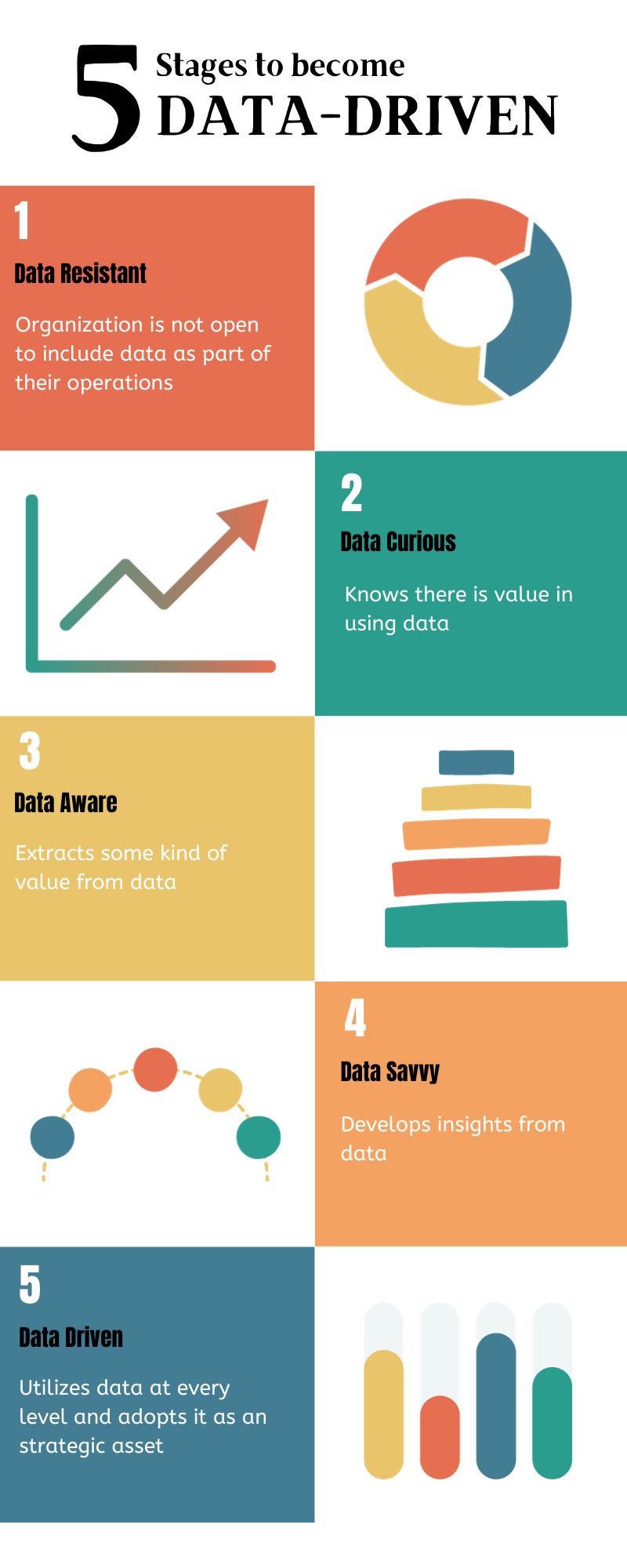An organization is not usually founded with a data-driven culture. For the most part, companies have to embark on a journey to become data-driven. There are 5 stages a company will go through to achieve this ultimate goal1.
Data-Resistant
When an organization is not using data in any form nor it is looking to employ data into their operations, we are talking about a data-resistant organization.
There might be some hidden reasons as to why a company is in this stage. Is it because they are unsure or afraid of what data might uncover? Are they hesitant about changing their way of doing things?
The truth is, the benefits of integrating data into an organization outweighs the motives for data opposition. Once a company starts utilizing data the right way, it will not want to go back.
Data-Curious
A data-curious organization realizes the implicit value of data. When a company moves from data-resistant to data-curious, stakeholders must be involved and receptive to change.
These companies are working towards collecting data from their own available sources, such as CRM platforms, ERP software, Google Analytics, Financial statements, etc. Data collecting is the first step in the data-driven journey.
Data-Aware
Data-aware organizations use data to understand the company state. They focus on descriptive analytics which is used to explain an event. Questions during this phase include the “What” such as “What happened?”, “What was the ROI for this project?”,”Which are our most sold products?”, etc.
Data enginering and data analysis are also part of the data-aware companies’ bread and butter. After data is collected, it is then cleaned and transformed for analysis. Some tools used for these processes are data storage or warehousing, ETL, and cloud computing.
Many organizations that are data-aware linger in this phase as they can measure their performance. The downside of staying put is that they are not going deep in analysis and engaging data into the decision-making process, a necessary qualifier in a data-driven organization.
Data-Savvy
Organizations that are data-savvy realize that data can be used as an strategic asset. In this phase, diagnostic analytics are implemented. After analyzing the “What”, they focus on the “Why”. “Why did sales go down last quarter”? , “Why are we losing customers”?, “Why has product A outperform product B?” .
When companies look for meaningful insights, i.e., what happened and why it happened, they can easily identify how the organization is performing and which practices have better outcomes than others.
Data-Driven
Data-driven organizations adopt data as part of their strategies in every part of their operations. They observe predictive and prescriptive analytics. On one hand, predictive analytics forecasts potential outcomes based on past data and it studies “What will happen?”. Meanwhile, prescriptive analytics recommends the course of action based on the data. “What should we do?” or “How can we make it happen?” are part of prescriptive analytics.
Every decision made in a data-driven company should be based on insights obtained from data analysis. Proper data collection and measurements should be implemented as well as part of the decision-making process.
It takes real commitment and effort to ensure an organization has a data-driven culture as this entails data is adopted at every level and included in every decision made. The benefits from being a data-driven company are countless and we will go over these in our next blog post!
- https://www.christopherspenn.com/2019/08/the-evolution-of-the-data-driven-company/ ↩︎
